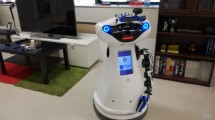Abstract
Using robotics to automate complex manipulation tasks such as cooking could offer significant advantages. Robotics could offer improved throughput, provide assistance for those that lack the required mobility or allow for creative robotic chefs. Generating a robotic system that utilizes vision systems, planning and dexterous manipulation would offer a generalized solution to kitchen tasks. However, there can be many components of the overall task that do not require this generalization. In addition, there remain many tasks for which it is quicker and preferable for a human to complete some sub-components of the task. By computing a complexity and similarity metrics from multiple examples of a human teaching the required motion we propose using unsupervised clustering to determine the approach method of implementation. This includes hard coding, use of vision, play back or human completion. We apply this analysis to the task of cooking pancakes in a kitchen environment, analyzing the trajectories, determining the method of completing the task using unsupervised methods and implementing the proposed approach.
Access this chapter
Tax calculation will be finalised at checkout
Purchases are for personal use only
Similar content being viewed by others
Notes
- 1.
Video of the automated process is available on the link: https://bit.ly/3QutTG8.
References
Ajoudani, A., Zanchettin, A.M., Ivaldi, S., Albu-Schäffer, A., Kosuge, K., Khatib, O.: Progress and prospects of the human–robot collaboration. Auton. Robots 42(5), 957–975 (2018)
Berndt, D.J., Clifford, J.: Using dynamic time warping to find patterns in time series. In: KDD workshop, vol. 10, pp. 359–370. Seattle, WA, USA (1994)
Billard, A., Kragic, D.: Trends and challenges in robot manipulation. Science, 364(6446):eaat8414 (2019)
Bogue, R.: Robots in the laboratory: a review of applications. Indus. Robot: Int. J. (2012)
Chiang, C.J., Chirikjian, G.S.: Modular robot motion planning using similarity metrics. Auton. Robots 10(1), 91–106 (2001)
Chua, P.Y., Ilschner, T., Caldwell, D.G.: Robotic manipulation of food products-a review. Indus. Robot: Int. J. (2003)
Dianatfar, Morteza, Latokartano, Jyrki, Lanz, Minna: Task balancing between human and robot in mid-heavy assembly tasks. Proc. CIRP 81, 157–161 (2019)
Dragan, A.D., Bauman, S., Forlizzi, J., Srinivasa, S.S.: Effects of robot motion on human-robot collaboration. In 2015 10th ACM/IEEE International Conference on Human-Robot Interaction (HRI), pp. 51–58. IEEE (2015)
Evangelou, George, Dimitropoulos, Nikos, Michalos, George, Makris, Sotiris: An approach for task and action planning in human–robot collaborative cells using AI. Proc. Cirp 97, 476–481 (2021)
Fonseca, E., Oliveira, I., Lobo, J., Mota, T., Martins, J., Au-Yong-Oliveira, M.: Kitchen robots: the importance and impact of technology on people’s quality of life. In World Conference on Information Systems and Technologies, pp. 186–197. Springer (2019)
Junge, K., Hughes, J., Thuruthel, T.G., Iida, F.: Improving robotic cooking using batch Bayesian optimization. IEEE Robot. Autom. Lett. 5(2), 760–765 (2020)
Kragic, D., Gustafson, J., Karaoguz, H., Jensfelt, P., Krug, R.: Interactive, collaborative robots: challenges and opportunities. In IJCAI, pp. 18–25 (2018)
Lei, Jie, Song, Mingli, Li, Ze-Nian., Chen, Chun: Whole-body humanoid robot imitation with pose similarity evaluation. Signal Process. 108, 136–146 (2015)
Makris, Sotiris, Tsarouchi, Panagiota, Surdilovic, Dragoljub, Krüger, Jörg.: Intuitive dual arm robot programming for assembly operations. CIRP Ann. 63(1), 13–16 (2014)
Ali Ahmad Malik and Arne Bilberg: Collaborative robots in assembly: a practical approach for tasks distribution. Proc. CIRP 81, 665–670 (2019)
Malik, A.A., Bilberg, A.: Complexity-based task allocation in human–robot collaborative assembly. Indus. Robot: Int. J. Robot. Res. Appl. (2019)
Rusu, R.B., Gerkey, B., Beetz, M.: Robots in the kitchen: exploiting ubiquitous sensing and actuation. Robot. Auton. Syst. 56(10), 844–856 (2008)
Villani, Valeria, Pini, Fabio, Leali, Francesco, Secchi, Cristian: Survey on human–robot collaboration in industrial settings: safety, intuitive interfaces and applications. Mechatronics 55, 248–266 (2018)
Acknowledgements
This project was partially funded by the European Union’s Horizon 2020 research and innovation programme under the Marie Skłodowska Curie grant agreement N\(^\circ \) 945363.
Author information
Authors and Affiliations
Corresponding author
Editor information
Editors and Affiliations
Rights and permissions
Copyright information
© 2023 The Author(s), under exclusive license to Springer Nature Switzerland AG
About this paper
Cite this paper
Ilic, S., Hughes, J. (2023). Complexity and Similarity Metrics for Unsupervised Identification of Programming Methods for Robot Cooking Tasks. In: Borja, P., Della Santina, C., Peternel, L., Torta, E. (eds) Human-Friendly Robotics 2022. HFR 2022. Springer Proceedings in Advanced Robotics, vol 26. Springer, Cham. https://doi.org/10.1007/978-3-031-22731-8_5
Download citation
DOI: https://doi.org/10.1007/978-3-031-22731-8_5
Published:
Publisher Name: Springer, Cham
Print ISBN: 978-3-031-22730-1
Online ISBN: 978-3-031-22731-8
eBook Packages: Intelligent Technologies and RoboticsIntelligent Technologies and Robotics (R0)




